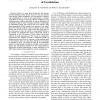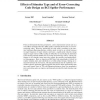60 search results - page 11 / 12 » Rehabilitation with Brain-Computer Interface Systems |
WSCG
2004
13 years 10 months ago
2004
Motor imagery electroencephalography (EEG), which embodies cortical potentials during mental simulation of left or right finger lifting tasks, can be used as neural input signals ...
IROS
2008
IEEE
14 years 3 months ago
2008
IEEE
— There is a great effort during the last decades towards building robotic devices that are worn by humans. These devices, called exoskeletons, are used mainly for support and re...
NIPS
2008
13 years 10 months ago
2008
From an information-theoretic perspective, a noisy transmission system such as a visual Brain-Computer Interface (BCI) speller could benefit from the use of errorcorrecting codes....
CHI
2008
ACM
14 years 9 months ago
2008
ACM
Mental illness has been identified as one of the greatest challenges facing society in the coming decades. However, there are significant barriers to access for many people suffer...
IJCNN
2008
IEEE
14 years 3 months ago
2008
IEEE
— A major challenge in applying machine learning methods to Brain-Computer Interfaces (BCIs) is to overcome the on-line non-stationarity of the data blocks. An effective BCI syst...


